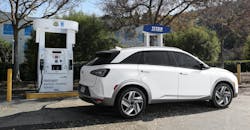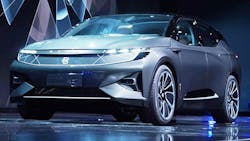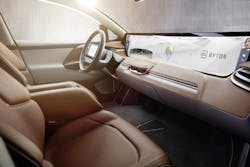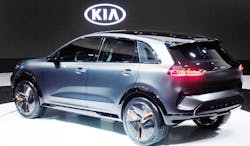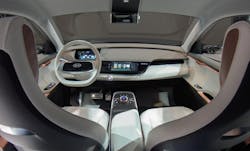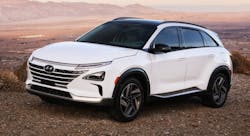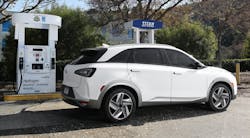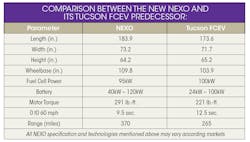With Concept Cars on Display, CES 2018 Gets Its Driver’s License
The Consumer Electronic Show (CES) has taken an abrupt detour from the show that started in 1998 in Las Vegas with personal computers and their peripherals. In 2018, several automotive concept cars were on the showroom floor in the CES. In the past, concept cars have been a mainstay of car shows. Now, however, with computers and electronics becoming such a major part of automobiles, CES is in the driver’s seat. Among concept cars at CES were those from companies in the Far East: Kia and Hyundai in South Korea and Byton in China.
Byton’s concept car will be manufactured at the company’s plant in Nanjing, China, and be available in China in 2019. The car will be available in the U.S. and Europe in 2020. Subsequent vehicles will be designed and produced based on the same platform (Fig.1).
1. Byton’s concept car includes Level 3/4 autonomous driving, which it plans to upgrade to Level 4 by 2020.
Byton’s first concept car combines technologies like Level 3/4 autonomous driving hardware, biometric identification, and a digitized cockpit with 4-ft.-long display. Byton intends to offer two all-electric powertrain options on its production SUV: a 268-hp single-motor rear-wheel (RWD) drive and a 469-hp dual-motor four-wheel drive (4WD). Torque figures are estimated at 295 and 524 lb.-ft., respectively.
The RWD will be powered by a 71-kWh battery with up to 249 miles of range, and the 4WD will offer up to 323 miles via a 95-kWh battery. Fast charging will bring the 71-kWh battery up to 80 percent in about 30 minutes, while the 95-kWh battery will require an extra five minutes to reach the same mark.
Key features include:
- Shared Experience Display (2): The car is equipped with multiple display screens, with the traditional center console replaced by a Shared Experience Display enabling content to be shared with the driver and passengers in the car.
- Human-Vehicle Interaction: Besides voice recognition, touch control, biometric identification, and necessary physical buttons, the car features proprietary Air Touch sensors, enabling front and rear passengers to control the Shared Experience Display with hand gestures.
- Byton Life Cloud Platform: This platform seamlessly connects a driver’s or passenger’s apps, data, and devices, allowing them to take full advantage of their travel time whether for work or entertainment. It also provides personalized services and configurations that are automatically adjusted according to users’ preferences.
- Byton Intuitive Access: This advanced secure unlocking method uses a facial recognition camera to recognize the driver or passenger, which unlocks the door.
- Interior and Exterior Digital Design: Among other digital design features, unique Byton Smart Surfaces composed of front and rear LED lights and a luminescent logo can switch to different display modes to suit different driving scenarios.
2. Shared Experience Display enables content to be shared with other passengers.
Kia’s Concept
Also at CES, Kia’s concept car is intended to demonstrate new technologies as part of its new ACE strategy to make its cars more Autonomous, Connected, and Eco/Electric.
- Autonomous: Kia plans to commercialize Level 4 autonomous driving technology, with ‘Smart City’ autonomous vehicle testing due to commence in 2021.
- Connected: By 2025, Kia will adopt connected car technologies across every vehicle segment, and aim to make every single model a connected car by 2030.
- Eco/Electric: Kia will introduce 16 new advanced powertrain vehicles by 2025, including a range of new hybrids, plug-in hybrids and electric vehicles, as well as an all-new fuel-cell electric vehicle in 2020.
Kia’s manifesto is for its role as a future mass mobility provider. Consumers are bound today by the idea that a car is “just a vehicle,” but Kia wants to provide a broader solution to mobility.
As part of its strategy, Kia exhibited the Niro EV Concept (Fig. 3) that combines the design of a modern compact SUV with the high efficiency of an advanced battery-electric powertrain. The Kia Niro EV Concept represents the next step in the company’s push to electrification.
3. Kia’s Niro EV Concept employs an electric vehicle powertrain, powered by a high-capacity 64 kWh lithium-polymer battery pack, paired with a powerful 150 kW electric motor.
Created by Kia’s design studio in South Korea, the Niro EV Concept is a fully electric compact SUV. Its aerodynamically efficient body allows air to slip over, around, and beneath the vehicle with ease. The traditional grille—no longer required for engine cooling—is replaced by a smooth interactive display panel, combined with ultra-slim lamp technology in the overall front. In profile, the concept draws inspiration from the current Kia Niro, with a modish compact crossover silhouette, elevated body, and wide C-pillar. The Niro EV Concept’s seamless rear aspect has clean and sharp trailing edges, allowing air to flow more easily off the back of the car.
With a silent electric powertrain, and the anticipation that such a car would be driven most frequently on urban and suburban roads, the Niro EV Concept boasts new technologies to enhance safety for pedestrians.
The concept’s new Active Pedestrian Warning System (APWS) combines front-view cameras, object recognition technology, and front speakers. If the system detects a pedestrian or cyclist crossing in front of the car, the speakers sound an alert targeted specifically at that person, warning them of the car’s presence. APWS is matched by the Niro EV Concept’s new interactive lighting system, which offers users and pedestrians a highly intuitive visual communication with vehicle.
4. Kia’s wrap-around dashboard design serves the driver and passengers. The infotainment and HVAC (heating, ventilation, and air conditioning) systems are controlled by touch and gesture, with the steering wheel acting as a remote.
Inside, the cabin has been designed with a pure, minimalist, and digital appearance, creating greater user interaction with new technologies and features (Fig. 4). The effect is an innate sense of space and calm in the cabin, enhanced by the soft shades of silver, gray, and bronze covering every surface.
The Niro EV Concept is powered by a next-generation electric-vehicle powertrain, using new production technologies earmarked for near-future EVs from Kia. Energy is provided by a high-capacity 64 kWh lithium-polymer battery pack, paired with a powerful 150 kW electric motor. The Niro EV Concept suggests a driving range of 238 miles, with zero tailpipe emissions.
Hyundai NEXO
Hyundai announced its concept, the NEXO, its all-new, dedicated fuel-cell EV (Fig.5). The company also disclosed that its Advanced Driver Assistance Systems (ADAS) will expand its autonomous driving potential.
5. Hyundai’s NEXO is a second-generation fuel-cell electric vehicle that will be available in select markets around the world starting in 2018.
The NEXO model will spearhead Hyundai Motor’s plans to accelerate development of low-emission vehicles, in line with Hyundai Motor Group’s renewed goal of introducing 18 eco-friendly models to global markets by 2025. This new development roadmap also represents the next step for Hyundai Motor toward realizing the ultimate ambition of creating a cleaner environment through eco-friendly vehicles.
Among the car’s features:
- Blind-spot View Monitor (BVM): While changing lanes in either direction, it uses wide-angle surround-view monitors on each side of the vehicle to monitor areas that cannot be seen by a traditional rearview mirror.
- Lane Following Assist (LFA) and Highway Driving Assist (HDA): Lane Following Assist is an all-new technology that debuts in the NEXO. LFA automatically adjusts steering to help keep NEXO centered in its lane of travel. LFA can keep NEXO centered at speeds between 0 and 90 miles per hour on both highways and city streets.
- Hyundai Highway Driving Assist (HDA): HAD utilizes sensors and map data to ensure safe operation as well as to automatically adjust speed in limited environments. Drivers will be able to traverse long distances with greater ease and improved safety.
- Remote Smart Parking Assist (RSPA): This enables NEXO to autonomously park or retrieve itself from a parking space with or without a driver in the car. The RSPA system can even back a NEXO into a parking spot by itself with a touch of a button from the driver.
Hydrogen Power
“Hydrogen energy is the key to building a more sustainable society. Hyundai Motor Company has already taken a lead in hydrogen technology with introduction of Tucson fuel cell,” saysDr. Woong-chul Yang, vice chairman, Hyundai Motor Company. “Yet as another result of this earth-saving effort, we are introducing our second-generation fuel-cell electric vehicle, which is a culmination of our cutting-edge technologies.” Figure 6 shows a hydrogen refueling station.
Figure 6. Hydrogen refueling station for the NEXO fuel cell electric vehicle.
NEXO is Hyundai’s second-generation of commercialized fuel cell electric vehicles that will be available in select markets around the world starting in early 2018. Improving upon the previous Tucson FCEV, the NEXO has an estimated driving range of 370 miles, 105 more than its predecessor. Acceleration and power have increased to improve the overall performance.
Designed to handle extreme temperature and environments, NEXO testing has proven that the vehicle is capable of starting after being subject to overnight temperatures of -20°F. NEXO boasts cold start capability within 30 seconds, which is an industry-leading achievement and the fuel-cell system warms up faster for maximum performance. NEXO also has excellent cooling performance on steep grades with temperatures exceeding 120°F.
Improvements in the air supply system, performance at high altitudes, and refueling times, along with overall efficiency and fuel economy, put NEXO in a class all its own. In addition, NEXO has improved power density and durability comparable with gasoline-powered vehicles.
For the first time, Hyundai’s fuel-cell vehicle is built with a dedicated vehicle architecture with features that include:
- Lighter weight
- Improved power-to-weight ratio
- Faster acceleration from 0 to 60 mph than the Tucson FCEV
- More cabin space
- Allowing the battery to be relocated in the trunk
- Improved fuel cell system layout
About the Author

Sam Davis
Sam Davis was the editor-in-chief of Power Electronics Technology magazine and website that is now part of Electronic Design. He has 18 years experience in electronic engineering design and management, six years in public relations and 25 years as a trade press editor. He holds a BSEE from Case-Western Reserve University, and did graduate work at the same school and UCLA. Sam was the editor for PCIM, the predecessor to Power Electronics Technology, from 1984 to 2004. His engineering experience includes circuit and system design for Litton Systems, Bunker-Ramo, Rocketdyne, and Clevite Corporation.. Design tasks included analog circuits, display systems, power supplies, underwater ordnance systems, and test systems. He also served as a program manager for a Litton Systems Navy program.
Sam is the author of Computer Data Displays, a book published by Prentice-Hall in the U.S. and Japan in 1969. He is also a recipient of the Jesse Neal Award for trade press editorial excellence, and has one patent for naval ship construction that simplifies electronic system integration.
You can also check out his Power Electronics blog.
